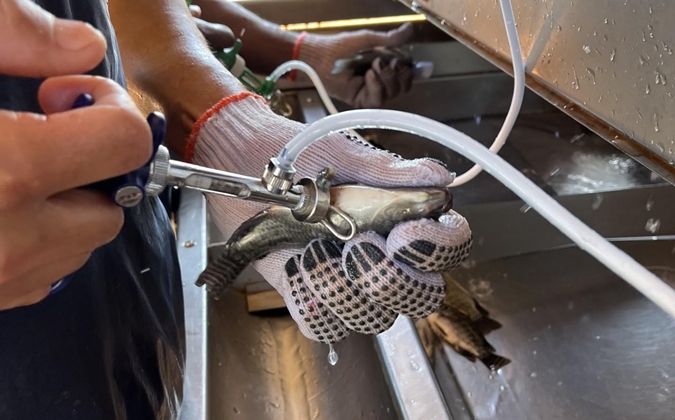
Fish Farm Forum is pleased to host this editorial page on behalf of Pharmaq.
Pharmaq
Vaccines boost Greece’s seabass and seabream aquaculture — but challenges remain
Aquaculture in Greece has endured some ups and downs since its establishment in the 1980s, from the Greek financial crisis to the Covid-19 pandemic. But changes in the management of fish health issues in the country’s industry are beginning to reap rewards.
Seabass and seabream are the most commonly farmed fish products in Greece. The commercial production of these species makes it the second most important aquaculture industry in the EU in value terms,1 while Greece ranks second behind Turkey among the Mediterranean countries producing the two fish.
Vaccination a focal point of disease management
The development of Greek seabream and seabass aquaculture has been associated with the application of novel vaccine technologies, among other factors.2
“Since the first fish vaccine introduction in the late ’90s, the results were satisfactory and that allowed the quite widespread usage,” explained Thanasis Prapas, of Athens-based aquaculture services company Aquavet SA.
Despite the gradual roll-out of vaccines, differing predisposition to disease of the two farmed species has led to a dual track in the development of options against new disease threats, he suggested.
“Seabass is the most susceptible species to a wide range of pathogens, both bacterial and viral, and has been the main target species for vaccine development. Seabream seems to be more resistant, and until now only immersion vaccines against Photobacterium damsella subsp. piscicida, which causes fish pasteurellosis, have been developed.”
New technologies and approaches make a difference
Prapas credits veterinary pharmaceutical companies operating in the sector with the development of vaccination regimes suitable for the protection of the fish through the whole production cycle.
Use of historical epidemiological data has also helped define the right timeframe for proper vaccination according to the onset of key bass and bream diseases, he noted, while a shift in how vaccines are delivered has further helped to cement modern disease-management practices in Greece.
“Until recently the most common technology was primarily vaccination by manual injection and to a lesser degree immersion vaccination, especially for the fry of both species,” Prapas continued.
“The major development in the industry has been the use of automatic vaccination machines which have been developed specifically for the Mediterranean species and mainly for seabass.”
Environment tests vaccination success
Barriers do remain in the successful administration of vaccines, however.
“The main challenge is the environment. In contrast with the salmon industry, and with seabass and bream farms in Spain, France and Italy, the vaccination here and in other parts of the eastern Mediterranean takes place in the sea rather than inland. This represents a major obstacle because, as you might anticipate, it is not always a very easy task to perform injection vaccination on a rough sea.”
“This might be overcome by performing the vaccination on smaller fish inland. Future research might also lie in the development of oral vaccines or even DNA vaccines,” he explained.
Despite the availability of a number of vaccines and improving practices, antibiotics are still regularly required for use against bacterial pathogens affecting seabass and seabream, with a selection of products registered for use in Greek aquaculture. In-feed antibiotics are used as part of a metaphylactic approach, whereby fish at risk of disease are targeted following the detection of sickness among some fish in a population.3
Staffing difficulties on aquaculture sites
Some of the practical challenges faced by Greek aquaculture fall more in the realm of human resources than fish biology, Prapas suggested.
“Staffing is a permanent issue and quite difficult to solve,” he said.
“To a certain extent the tourist industry might interfere in some places, but this is not as much of a problem as previously, since the vast majority of the fish farms are located in rather remote areas, and there is a trend to move them off-shore.”
The coronavirus pandemic has compounded such issues. Enforced personnel limits on sites have caused delays on fish vaccination, he explained, given the need for a large number of people in a small area to carry out injection of fish.
Despite recent setbacks, there is still plenty of optimism in the sector, he added. Fish farms in Greece were among the first to be awarded the new Seabass, Seabream, and Meagre Standard from the Aquaculture Stewardship Council, suggesting there is appetite for market growth alongside due consideration for fish health and welfare.
1 Llorente I, Fernández-Polanco J, Baraibar-Diez E, Odriozola MD, Bjørndal T, Asche F, Guillen J, Avdelas L, Nielsen R, Cozzolino M. Assessment of the economic performance of the seabream and seabass aquaculture industry in the european union. Mar Policy. 2020;117:103876.
2 Theodorou JA, Perdikaris C, Filippopoulos NG. Evolution through innovation in aquaculture: A critical review of the greek mariculture industry. J Appl Aquacult. 2015;27(2):160-81.
3 Rigos G, Kogiannou D, Padrós F, Cristòfol C, Florio D, Fioravanti M, Zarza C. Best therapeutic practices for the use of antibacterial agents in finfish aquaculture: A particular view on european seabass (dicentrarchus labrax) and gilthead seabream (sparus aurata) in mediterranean aquaculture. Rev Aquacult. 2020.
Posted on: December 03, 2021







